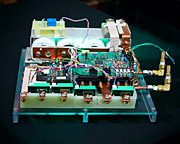- Number 307 |
- March 15, 2010
Power to spare for hybrid-electric autos

The PHEV's traction drive system
is used to charge the battery,
power the vehicle and enable its
mobile energy source capabilities.
An advancement in hybrid electric vehicle technology is providing powerful benefits beyond transportation.
Researchers at DOE's's Oak Ridge National Laboratory have designed, fabricated and demonstrated a PHEV traction drive power electronics system that provides significant mobile power generation and vehicle-to-grid support capabilities.
"The new technology eliminates the separate charging mechanism typically used in PHEVs, reducing both cost and volume under the hood," said Gui-Jia Su of ORNL's Power Electronics and Electric Machinery Research Center. "The PHEV's traction drive system is used to charge the battery, power the vehicle and enable its mobile energy source capabilities."
Providing more power than typical freestanding portable generators, the PHEV can be used in emergency situations such as power outages and roadside breakdowns or leisure occasions such as camping. Day-to-day, the PHEV can be used to power homes or businesses or supply power to the grid when power load is high, according to Su.
The charging system concept, which is market ready, could also be used to enhance the voltage stability of the grid by providing reactive power, Su said. The Power Electronics and Electric Machinery Research Center is DOE's broad-based research center helping lead the nation's advancing shift from petroleum-powered to hybrid-electric and plug-in hybrid vehicles. The center's efforts directly support DOE's Vehicle Technologies Program and its goal to provide Americans with greater freedom of mobility and energy security while lowering costs and reducing impacts on the environment.
[Kathy Graham, 865.946.1861,
grahamkj@ornl.gov]
